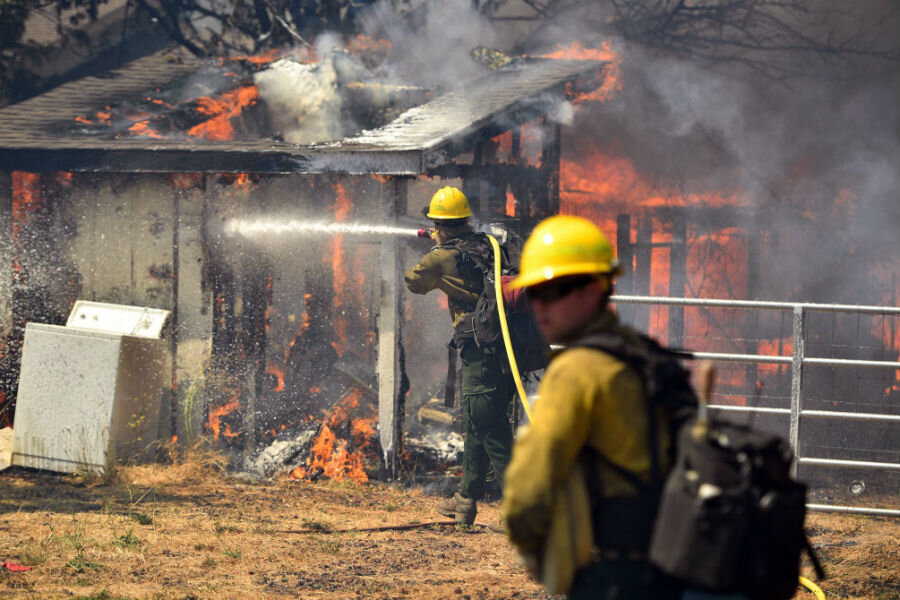As California's wildfire risks grow, are home builders getting the message?
Loading...
With a historic drought and high temperatures, California is seeing longer and deadlier wildfire seasons – but the threat has not deterred developers from rebuilding homes in wilderness areas most prone to fires.
Since 1990, the number of homes located in or near wilderness areas has grown by nearly 25 percent in the 13 Western states where 70 percent of the nation’s wildfire occurs, according to research by the US Forest Service and the University of Wisconsin, as the Wall Street Journal reports. Data from the Forest Service finds that California has the highest concentration of housing units in wilderness areas of all 50 states, followed by Texas and Florida. And that figure could keep rising: 84 percent of the state's private wildlands are available for development, according to Headwaters Economics, a nonprofit group researching land management.
"We are increasingly building our homes ... in fire-prone ecosystems," Dominik Kulakowski, an associate professor of geography at Clark University in Worcester, Mass., told The Christian Science Monitor in 2013. Doing that "in many of the forests of the Western US ... is like building homes on the side of an active volcano."
The threat of fire has not diminished the thirst for development in wilderness, some analysts say, because the developers are not expected to shoulder the cost of firefighting – and the the demand for housing in these areas is too high to ignore.
“When things go wrong, the cost of that is borne by someone else,” Ray Rasker, the executive director of Headwaters Economics, told The Wall Street Journal. “That’s the disconnect.”
Firefighting for wildfires is paid by the Forest Service, although the extent of recent fires have triggered debate in Congress about who should pay for the increasingly costly efforts. Fifty-two percent of the Forest Service's budget was set aside for fire suppression last year; 20 years ago, that was just 16 percent.
And California has the highest total fire expenditures in the country, according to US Forest Service data. In a single week in 2015, the cost of fighting its fires reached a record $243 million. The reason for those high costs: more Californians live near wilderness areas. Often, fire crews will let truly wild areas burn under surveillance, but protecting homes at the edge of the wilderness demand comes at a high cost.
Building houses near wilderness areas can be dangerous because the development is in close proximity with dry fuels – bushes and trees – that can burn easily, especially during dry and hot seasons. But housing demand in these areas continues to increase, especially for seasonal homes, as the location often boasts scenic views and quiet settings. Population growth compounded with the expected retirement of more Baby Boomers are expected to boost the trend, especially as housing costs in cities continue to push home buyers out into relatively rural areas.
This occurs even as scientists predict larger, more frequent and intense wildfire seasons. LeRoy Westerling, a professor at University of California-Merced, found that the number of fires on public lands in the west has increased by 500 percent since the late 1970s, as Scientific American reports. Secretary of Agriculture Tom Vilsack wrote in a blog post last year that climate change and other factors will continue to exacerbate the situation – while sapping the Forest Service budget.
Since January, California has seen over 4,000 cases of wildfires covering more than 200,000 acres of land (the five-year average is 160,000 acres). The number of fires is forecast to worsen in the next few months as the Santa Ana desert winds are expected to bring in high temperatures and dry conditions.
More and more of the year is becoming fire season, Cal Fire's Southern Region information officer, Michael Mohler, told NPR last month, noting that he also sees an increase in homes in fire-prone areas.
"The explosive fire growth statewide is unfortunately the new normal. We're seeing fire conditions that are unprecedented," Mr. Mohler said, saying Cal Fire would need to study new models and equipment for "year-round response just to battle those types of fires."








